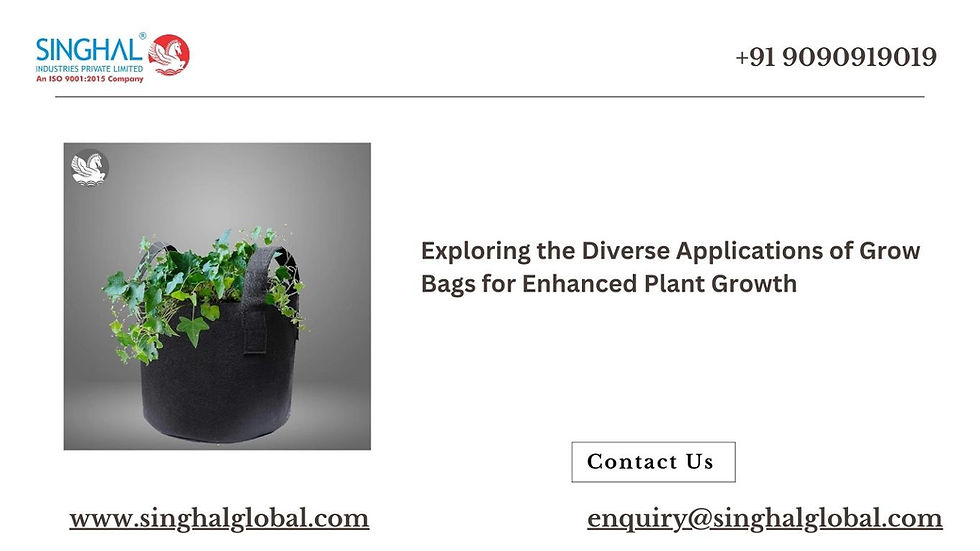Exploring the Diverse Applications of Grow Bags for Enhanced Plant Growth
- singhalglobal group

- Aug 23, 2023
- 3 min read
Introduction
When it comes to cultivating healthy and vibrant plants, the choice of containers can significantly impact their growth. Grow bags have gained popularity as a versatile and practical option for various applications in gardening and agriculture.
These bags offer numerous benefits, such as improved aeration, better drainage, and enhanced root development. In this comprehensive guide, we'll delve into the diverse applications of grow bags and how they can help unlock the full potential of plant growth.

Applications of Grow Bags
Container Gardening with Grow Bags
Container gardening has become a preferred method for urban and space-restricted gardeners. Grow bags provide an excellent solution for growing plants in limited spaces, such as balconies, patios, and rooftops. Their lightweight and portable nature allows gardeners to rearrange plants with ease to optimize sunlight exposure and aesthetic arrangements.
Hydroponic Systems and Grow Bags
Hydroponic gardening relies on nutrient-rich water solutions instead of soil. Grow bags play a vital role in hydroponic systems by providing a stable and controlled environment for plant roots to absorb nutrients. The porous material of grow bags facilitates nutrient distribution while preventing waterlogging, ensuring healthier and faster plant growth.
Nursery and Transplanting
Nurseries benefit from using grow bags to cultivate young plants before transplanting them to larger outdoor spaces. The controlled environment of grow bags encourages strong root development, minimizing transplant shock. Gardeners can seamlessly transplant seedlings, trees, and shrubs into their intended locations, enhancing overall survival rates.
Urban Landscaping and Beautification
Urban landscaping projects often require plants to be aesthetically pleasing, versatile, and easy to maintain. Grow bags are an ideal choice for urban beautification due to their flexibility and adaptability. From adorning sidewalks with colorful flowers to greening up public spaces, grow bags offer an effective way to enhance urban environments.
Commercial Agriculture with Grow Bags
Large-scale agricultural operations can also reap the benefits of using grow bags. Grow bags are particularly useful for crops with shallow root systems, such as strawberries, tomatoes, and herbs. Commercial farmers can optimize space, improve crop yield, and streamline harvesting processes by incorporating grow bags into their operations.
Greenhouses and Controlled Environments
Grow bags are well-suited for greenhouse cultivation, where maintaining optimal growing conditions is crucial. Their excellent drainage properties prevent overwatering, while the controlled environment of greenhouses ensures plants receive adequate sunlight and protection from harsh weather conditions.
Vertical Gardening Solutions
Vertical gardening has gained traction as a space-efficient way to grow plants vertically, making use of walls, fences, and trellises. Grow bags can be suspended on vertical structures, allowing cascading plants to flourish. This innovative application maximizes available space and adds a stunning visual element to any area.
Revegetation and Ecological Restoration
In ecological restoration projects, the successful establishment of native plants is paramount. Grow bags aid in revegetation efforts by nurturing young plants until they're strong enough to thrive in their natural habitats. This approach ensures a higher survival rate for transplanted flora, contributing to the restoration of ecosystems.
Aiding Soil Decontamination
Grow bags are also instrumental in remediating soil-contaminated areas. Certain plant species have the ability to absorb pollutants from the soil, a process known as phytoremediation. Grow bags can be strategically placed in contaminated sites to facilitate this purification process, gradually improving soil quality.
Frequently Asked Questions (FAQs)
Q: Can I reuse grow bags for multiple growing seasons?
A: Absolutely! Grow bags are durable and can be reused for several seasons, making them a sustainable choice for gardening.
Q: How often should I water plants in grow bags?
A: The frequency of watering depends on factors like plant type, weather, and bag size. Generally, grow bags require more frequent watering compared to traditional containers.
Q: Are grow bags suitable for larger plants and trees?
A: Yes, grow bags come in various sizes to accommodate plants of different sizes. They are particularly beneficial for promoting healthy root growth in larger plants.
Q: Can I use grow bags indoors?
A: Yes, grow bags can be used indoors as long as there's sufficient sunlight and proper drainage. They're a great option for growing herbs and small flowering plants indoors.
Q: Are there specific plants that benefit the most from grow bags?
A: Plants with shallow root systems, such as peppers, strawberries, and lettuce, tend to benefit the most from grow bags. However, many different plant types can thrive in grow bags.
Q: How can I prevent grow bags from tipping over?
A: To prevent toppling, ensure that the grow bags are placed on a stable surface or anchored to prevent strong winds from knocking them over.
Conclusion
As we've explored, the applications of grow bags are vast and diverse, ranging from urban gardening to large-scale agriculture and ecological restoration. These versatile containers offer numerous advantages, including improved aeration, better drainage, and enhanced root development. Whether you're a home gardener, a commercial farmer, or an environmental enthusiast, integrating grow bags into your plant-growing endeavors can lead to healthier and more vibrant vegetation. So, unlock the potential of your plants with the innovative and adaptable solutions provided by grow bags.
Comments